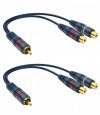I have two sets of speakers and I want to drive them from two seprate power amps, like, Fosi v3's.
The setup would be: (audio source) -> (potentially a DAC) -> [two different amps] -> two sets of speakers
My naive idea is just to split the RCA cable between the source/DAC and the amps, but I'm not sure if that's the best way. My concern is about timing effects and/or other gotchas. In theory the speakers are far enough apart that it shouldn't matter a whole lot - but sound from one room will blead into the other, since there's an open hallway between them.
Anyway, are there best practices here I should think about?
The setup would be: (audio source) -> (potentially a DAC) -> [two different amps] -> two sets of speakers
My naive idea is just to split the RCA cable between the source/DAC and the amps, but I'm not sure if that's the best way. My concern is about timing effects and/or other gotchas. In theory the speakers are far enough apart that it shouldn't matter a whole lot - but sound from one room will blead into the other, since there's an open hallway between them.
Anyway, are there best practices here I should think about?

